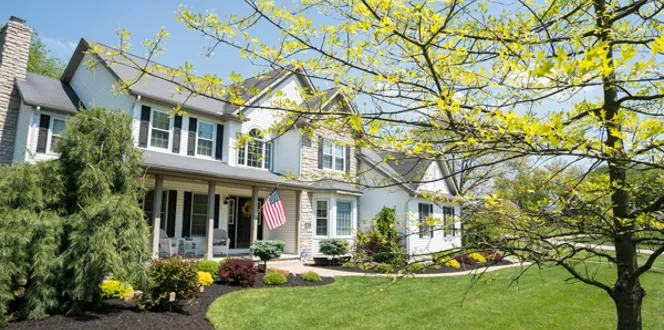For a shade tree that offers a grand, majestic canopy, you can’t beat an elm.
In fact, elm-lined streets were extremely popular in the early 1900s before Dutch elm disease hit many elm trees in the 1930s.
Luckily, there have been many efforts to try and restore elms! Not all elms are susceptible to Dutch elm disease.
You may already have an elm tree in your yard or maybe you’re thinking about planting one. Either way, we can help you with your elm tree identification and offer some care tips so your elm tree can thrive, offering you lasting shade for years to come.
What Does An Elm Tree Look Like?
Elm trees are large, deciduous trees that can grow up to 100 feet tall with a 75-foot spread.
They have distinguished, rough, grooved bark and pointed, oval leaves with saw-toothed edges that stand out in your landscape.
Elm Tree Leaves
An elm tree’s leaves are oval with jagged edges and a pointed tip. Half of the leaf is typically shorter than the other, giving the leaf a slightly lopsided appearance.
In each leaf, which is light to dark green and about 4 to 6 inches long, you can see visible veins.
In autumn, elm tree leaves turn a golden yellow, brightening up your yard.
Elm Tree Bark
Elm tree bark is quite classic. It is darkish brown in color with bits of gray and has deep, vertical ridges.
Elm tree wood is quite strong, yet flexible. It resists rotting and splitting. As such, it’s been used to make furniture, instruments, and even archery bows.
3 Common Types of Elm Trees
Most types of elm trees like sun or partial shade. Here are three of the more common types of elms you usually see in home landscapes.
American Elm Tree
- Grow Zones: American elm trees grow best in USDA zones 2 to 9. It’s the state tree of both Massachusetts and North Dakota.
- Height/spread: This tall shade tree has a vase-shaped canopy with a spread of 40 to 75 feet and can grow to 60 to 90 feet tall.
- Sunlight: The American elm tree prefers full sun.
- Best time to prune: Because open wounds can attract the elm bark beetle, which helps spread Dutch elm disease, avoid pruning these trees between April and July. The best time to prune them would be in winter or very early spring ahead of the growing season.
- Potential Threats: The American elm was widely planted in the early 19th century, and that lack of diversity caused Dutch elm disease to spread. But a number of newer cultivars have been bred with disease resistance, including ‘Valley Forge,’ ‘Princeton,’ and ‘New Harmony.’
Chinese Elm Tree
- Grow Zones: The Chinese elm tree, with its rounded shape and distinctive, exfoliating bark in browns, grays, and oranges, grows best in zones 5 to 9.
- Height/spread: Offering a similar vase shape to American elm, this tree can grow to a height of 40 to 50 feet, although most landscape specimens reach 15-20 ft. This species of elm has smaller leaves than American Elm.
- Sunlight: The Chinese elm prefers full sun. Though it adapts to many soil types, it prefers moist but well-drained conditions.
- Best time to prune: Prune this tree when it is ready for new growth during late dormancy before buds begin to form.
- Potential Threats: Wood rot diseases can be problems when these trees are not planted in preferred growing conditions.
Cedar Elm Tree
- Grow Zones: The cedar elm tree prefers USDA zones 6 to 9. Though it has no similarities to the cedar tree, it gets its name from being frequently found near junipers, which are sometimes known as cedars.
- Height/spread: Cedar elms can grow up to 50 to 70 feet tall. This species of elm has smaller leaves.
- Sunlight: These trees prefer full sun.
- Best time to prune: Prune your cedar elm in late spring or early summer.
- Potential Threats: The cedar elm is susceptible to Dutch elm disease, but not as much as the American elm. This tree tolerates pollution, drought, and poor soil.
What Does a Dead Elm Tree Look Like
Though it’s not a sight you want to see, it’s important that you know what a dead elm tree looks like so you can tell whether your tree is thriving or suffering.
First, look for a lack of leaves. A dying elm may have missing leaves and hanging branches.
Then, you’ll want to look at the bark. Dead elm tree bark will be light gray to dark gray with only a hint of the brown left. You might even notice the bark is cracking or splitting from the tree or missing in chunks.
You might also notice fungi growing on the tree’s trunk. Fungi feed on decaying wood, so their presence can be a sign of deadwood beneath them.





